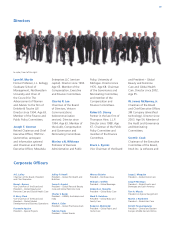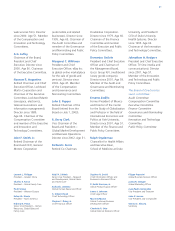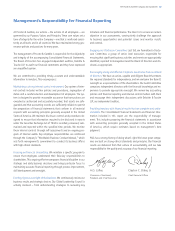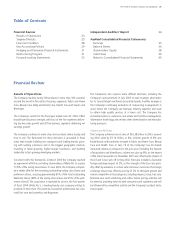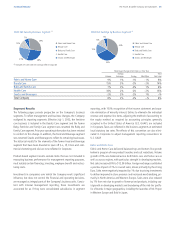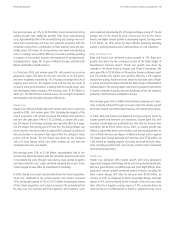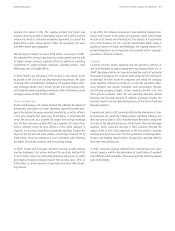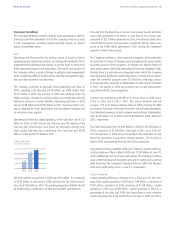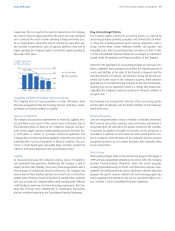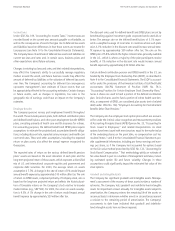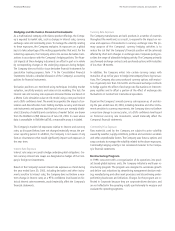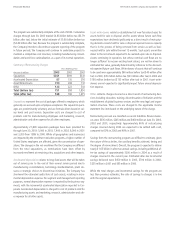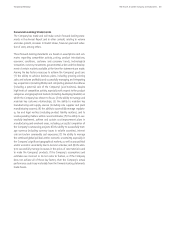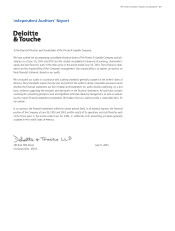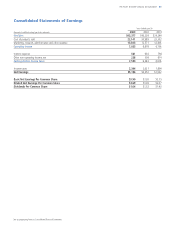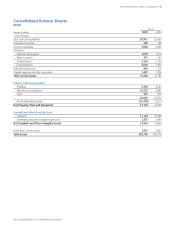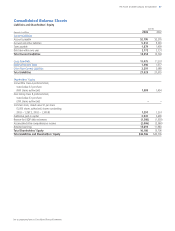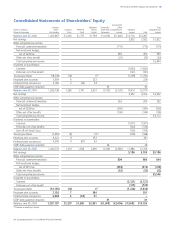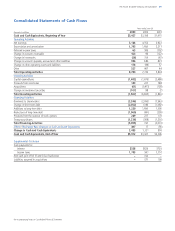Proctor and Gamble 2003 Annual Report Download - page 31
Download and view the complete annual report
Please find page 31 of the 2003 Proctor and Gamble annual report below. You can navigate through the pages in the report by either clicking on the pages listed below, or by using the keyword search tool below to find specific information within the annual report.
Financial Review 29The Procter & Gamble Company and Subsidiaries
Key Accounting Policies
The Company applies certain key accounting policies as required by
accounting principles generally accepted in the United States of Ameri-
ca. These key accounting policies govern revenue recognition, restruc-
turing, income taxes, certain employee benefits and goodwill and
intangible assets. These accounting policies, and others set forth in Note
1 to the Consolidated Financial Statements, are integral to understand-
ing the results of operations and financial condition of the Company.
Inherent in the application of accounting principles are necessary esti-
mates, judgments and assumptions that affect the reported amount of
assets and liabilities at the date of the financial statements and the
reported amounts of revenues and expenses during the periods pre-
sented. Due to the nature of the Company’s business, these estimates
generally are not considered highly uncertain at the time of estimation,
meaning they are not expected to result in a change that would mate-
rially affect the Company’s results of operations or financial condition in
any given year.
The Company has discussed the selection of key accounting policies
and the effect of estimates with the Audit Committee of the Company’s
Board of Directors.
Revenue Recognition
Sales are recognized when revenue is realized or realizable and earned.
Most revenue transactions represent sales of inventory, and revenue is
recognized when risk and title to the product transfers to the customer.
A provision for payment discounts and product return allowances is
recorded as a reduction of sales within the same period that the reve-
nue is recognized. Given the nature of the Company’s business, revenue
recognition practices do not contain estimates that materially affect
results of operations.
Restructuring
Restructuring charges relate to the restructuring program that began in
1999 and was substantially complete at the end of 2003. The Company
provides forward-looking information about the overall program,
including estimated savings and costs. Such disclosures represent man-
agement’s best estimate and do require significant estimates about the
program. The specific reserves related to the restructuring program also
require judgment and estimation, but are not considered highly uncer-
tain. See Note 2 to the Consolidated Financial Statements.
respectively. This is a result of the systemic interventions the Company
has made to improve capital spending efficiencies and asset utilization
and is primarily the result of lower spending in Baby and Family Care.
On an ongoing basis, while there may be exceptional years when spe-
cific business circumstances, such as capacity additions, may lead to
higher spending, the Company’s goal is to maintain capital spending at
about 4% of net sales.
Guarantees and Other Off-Balance Sheet Arrangements
The Company does not have guarantees or other off-balance sheet
financing arrangements that the Company believes could have a mate-
rial impact on financial condition or liquidity.
Purchase Commitments
The Company has purchase commitments for materials, supplies, serv-
ices and fixed assets as part of the normal course of business. Due to
the proprietary nature of many of the Company’s materials and proc-
esses, certain supply contracts contain penalty provisions for either ear-
ly termination or failure to purchase contracted quantities. The
Company does not expect potential payments under these provisions to
materially affect results of operations or financial condition. This con-
clusion is made based upon reasonably likely outcomes assumed by
reference to historical experience and current business plans.
Liquidity
As discussed previously, the Company’s primary source of liquidity is
cash generated from operations. Additionally, the Company is able to
support its short-term liquidity, if necessary, through agreements with a
diverse group of creditworthy financial institutions. The Company has
never drawn on these facilities and does not intend to do so in the fore-
seeable future. However, should the facilities be needed, when combined
with cash on hand, the Company believes they would provide sufficient
credit funding to meet any short-term financing requirements. The Com-
pany does not have other commitments or related party transactions
that are considered material to the Consolidated Financial Statements.
Capital Spending
(in billions of dollars)
20001999
0
1
2
3
$4
2%
0%
4%
6%
8%
2001 2002 2003
% of Net Sales
Capital Spending



